Just like other advertising platforms, your Facebook advertising campaign goals can be designed to reach, engage, and convert.
Every goal’s success is measured with specific primary metrics.
As a result, the objective you choose will determine what optimization and bidding options you have throughout your campaign setup.
Facebook is smart. The system is will equip you with the most relevant tools when it knows what you want to accomplish.
What is an objective in Facebook?
The first thing you do with every Facebook advertising campaign is selecting your campaign objective.
In this article you’ll learn the 11 Facebook advertising campaign objectives (as of now), what they are, and when best to use them.
There are also some example ads to give you some inspiration for your next campaign.
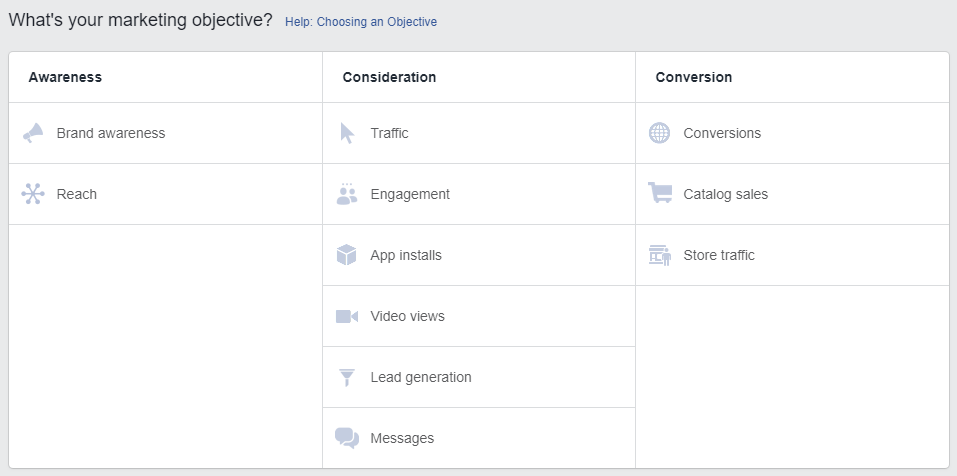
- Brand awareness
- Reach
- Traffic
- Engagement
- App installs
- Video views
- Lead generation
- Messages
- Conversions
- Catalog sales
- Store traffic
Pro tip: the right objective will affect your ad delivery, bidding options, and ad costs.
How do you choose the right Facebook campaign objective?
Here’s the rule of thumb. Choose your objective based on your overall marketing and advertising strategy.
It’s broken up into three areas; Awareness, Consideration, Conversion.
Therefore, if you are building your brand or launching new products, and want maximum reach, then you go with “Reach” objective or “Brand awareness.”
On the other hand, if you want to drive conversions to your eCommerce site, then “Catalog sales” or “Conversions” would be the most appropriate.
Let’s dive in…
In this article, I will cover the list of Facebook campaign objectives, the Facebook ad formats, and pro tips on Facebook campaign optimizations options.
1) Campaign Objective: Brand Awareness
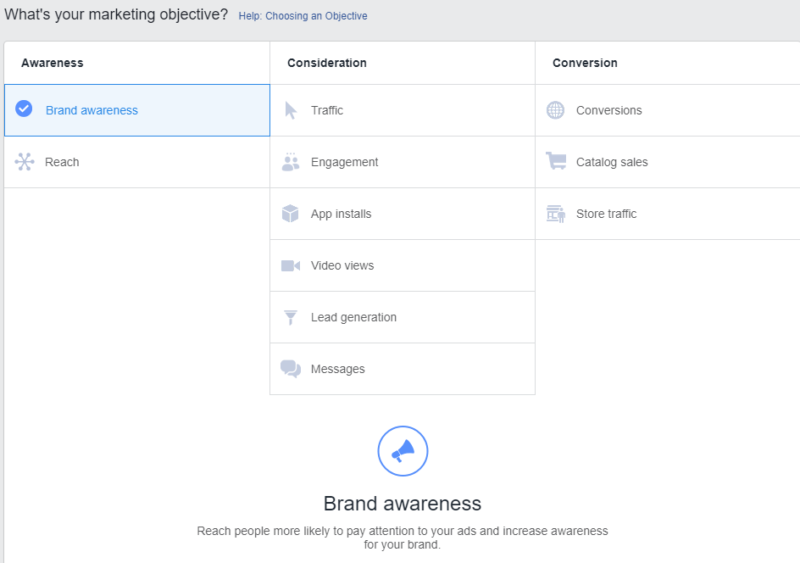
When should you use a Brand Awareness objective?
This objective is the ideal option if you are building your brand’s visibility.
Businesses that want to put their brand in front of as many people as possible; whether for a new store launch, latest product releases, or reinforcing brand position should choose this objective.
Your ads will be shown to as many people in the audience segment you are targeting for your business.
Facebook’s ad algorithm will optimize for your objective by showing ads to people who are most likely to recall seeing your ad later down the purchase funnel.
2) Campaign Objective: Reach

When should you use a Reach objective?
This objective is ideal for a time-based campaign.
If you want to reach the most people in your audience repeatedly over a short period of time.
For example, if you are running an exclusive limited-time online offer for your latest “magical green widget” and want to be seen by everyone in your audience.
Choose “Reach” as your objective and Facebook will automatically optimize your spend for the maximum number of impressions. You can also set the how many times your audience sees your ad.
Here’s an example: X impressions every Y days (6 impressions every 2 days).
“But Derek, doesn’t this contradict the Conversion objective”? Great question!
Au contraire. Because when you are running a time-based campaign, you want to put your ads in front of as many as possible.
3) Campaign Objective: Traffic
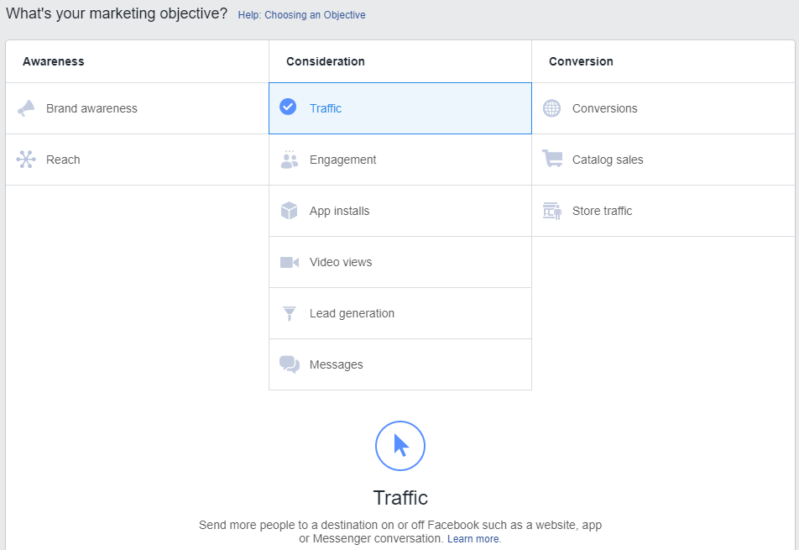
When should you use a Traffic objective?
As its name implies, this is the objective you choose when your business goal is to get people to click to your website, blog, content, case studies, or landing pages — period.
There’s nothing else you want from this audience.
After you have built your awareness and reached as many people in your audience segment as you can, this objective is to take them off Facebook to your destination.
We use this campaign when our clients are looking to drive website traffic that and then retarget the audience back on Facebook in their conversion campaign.
Pro tip: we recommend setting your optimization for ad delivery to landing page views. Why? In short, the FB pixel will load when the page is fully loaded (or viewed) — and your tracking will be more accurate.
4) Campaign Objective: Engagement
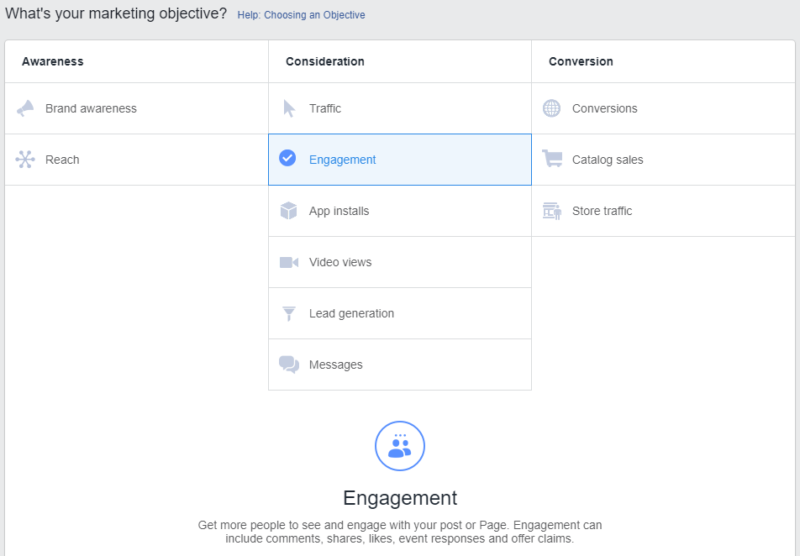
When should you use a Engagement objective?
The engagement objective is unique.
Facebook consolidated the page like and event responses objective under engagement — make sense.
It gives you three campaign options — getting more page likes, set up event responses.

Engagement campaigns drive likes, shares, comments, responses — at the lowest cost possible.
Facebook will serve your ads to people in your audience who are most likely to perform one of those actions.
How? Based on their behavior that Facebook tracks.
If you are running a Facebook giveaway contest, hosting an event, or simply getting more people to connect with your brand by liking your page — this objective is the most suitable.
5) Campaign Objective: App installs
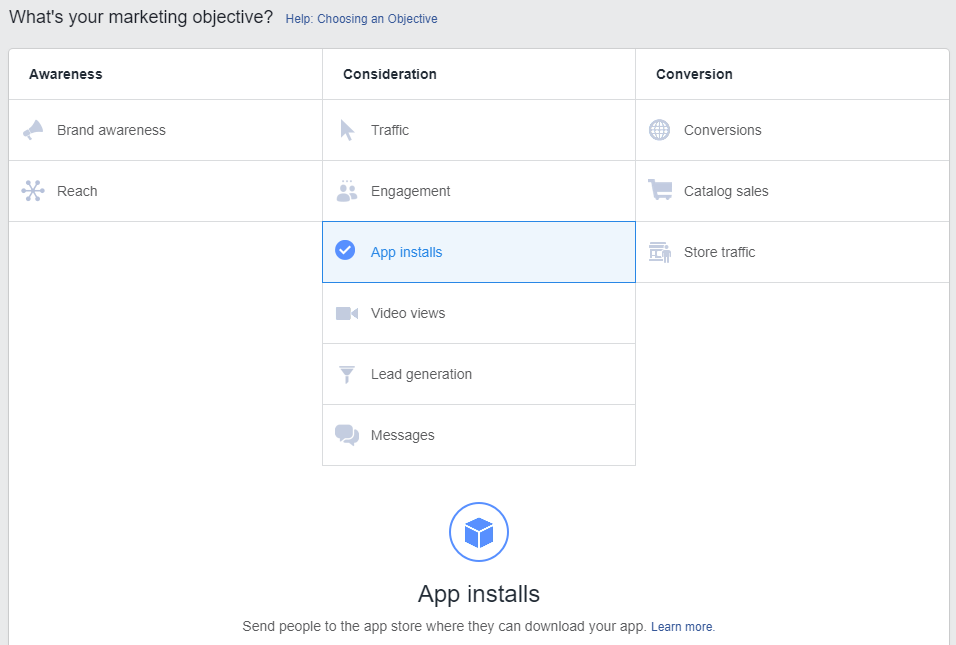
When should you use a App installs objective?
Have an app in Google Play or iTunes? Who doesn’t. Right?
This is the objective to use.
Using any other objectives (besides Conversion) will not let you link to your app store.
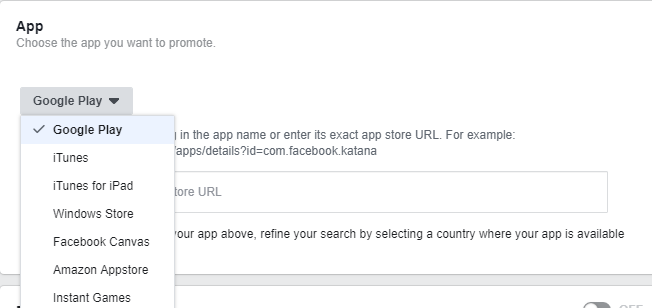
Pro tip: You can only select one app store per campaign. So if you have your app in Google Play and iTunes, then you will need to launch two separate campaigns.
6) Campaign Objective: Video views
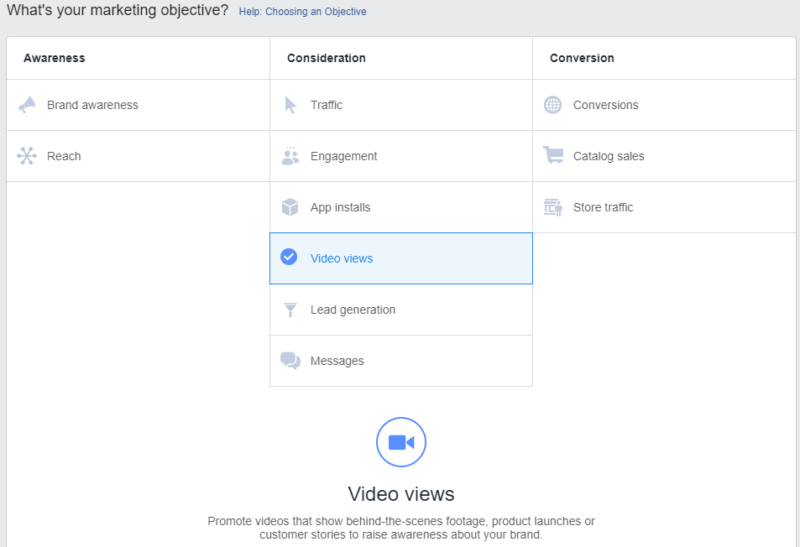
When should you use a Video views objective?
Personally, I love the video views objective.
Video ads are incredibility engaging, cheap (for now), and drives massive awareness.
We have launched so many video view campaigns that costs $0.03 per video view. Imagine what a $10,000 video campaign budget can do!
If you’re not using videos in your ads, consider testing it. Video content can change the way your audience engages with you and drive serious incremental traffic.
We launched several video campaign for one of our automotive clients and not only did it reach a massive audience, it generated 700% – 900% return on the ad spend.

7) Campaign Objective: Lead generation
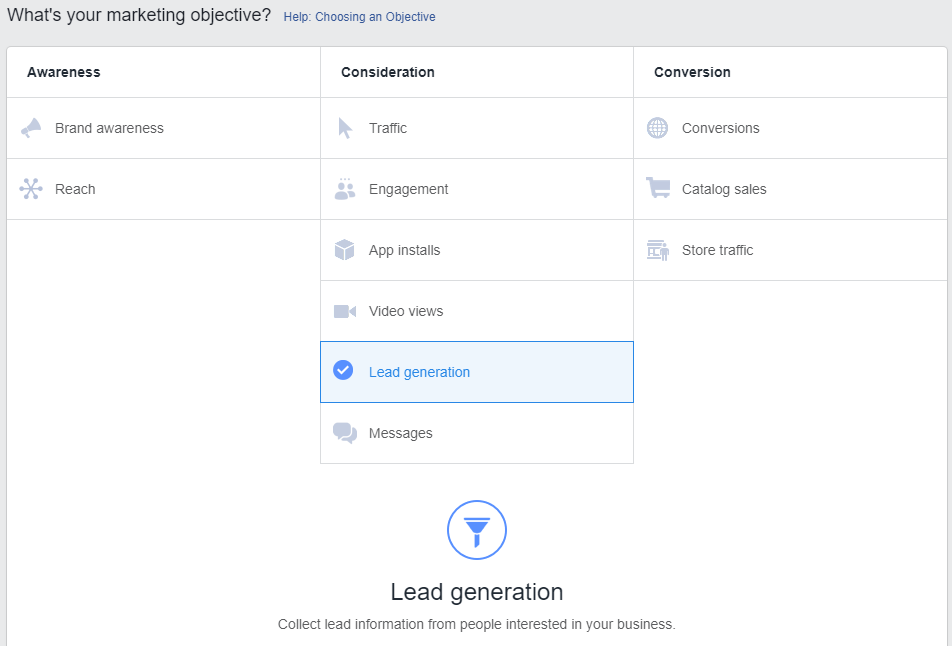
When should you use a Lead generation objective?
This objective lets you collect user contact information in exchange for downloadable content, contacting you for a proposal, or signing up for a webinar.
The user won’t leave Facebook at all.
Pro tip: limit the information you require. There’s a balance of too many or too few. Test and see what gets you the highest submission rates.
Instead of sending users to your website, a lead form pops up.
Your form can collect information like names, emails, phone numbers, etc. directly on Facebook. The experience friction-less.
8) Campaign Objective: Messages
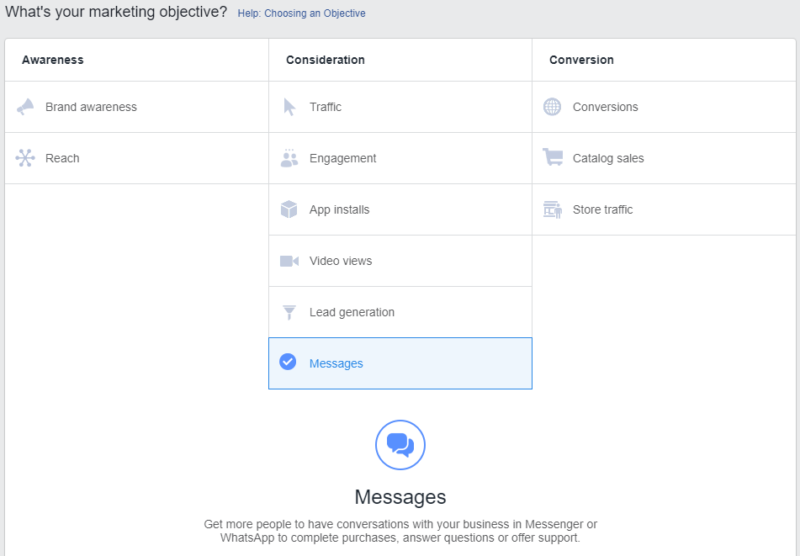
When should you use a Messages objective?
Depending your your messenger destination, Facebook will either deliver your ads to people as many times as possible or to people most likely to have a conversation with you through messages.
If you are looking to start conversations with your audience, this is the objective you choose.
One of the best applications for messenger is answering customer questions and support.
Because your audience spend so many hours on Facebook, connecting with them via messenger can be what sets you a part from the competition.
9) Campaign Objective: Conversions
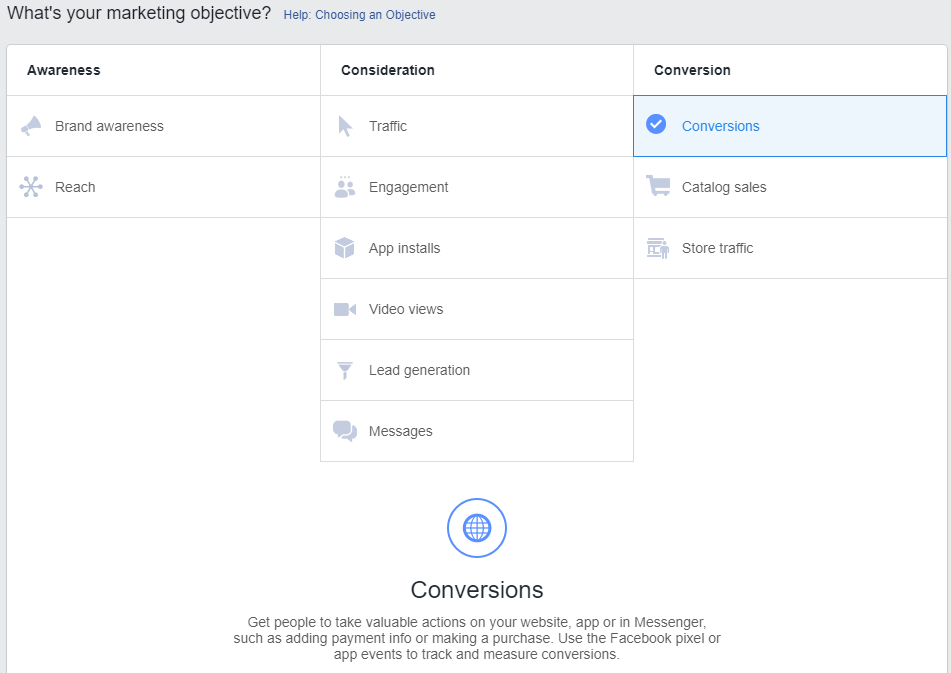
When should you use a Conversions objective?
This objective is one of the most used in Facebook advertising campaigns.
Whether leads or sales, this conversion objective, Facebook’s conversion optimization algorithm does the trick.
Pro tip: setting up your audience segments is key to optimizing your conversion campaigns. Constantly test several ad formats and variations.
Even though this is a conversion objective, the audience you serve your ads to will also end up liking, commenting, and sharing your post.
Reach and engagement is a natural behavior of social advertising. The difference is what you can optimize by selecting a conversion objective instead of the others.
10) Campaign Objective: Catalog sales
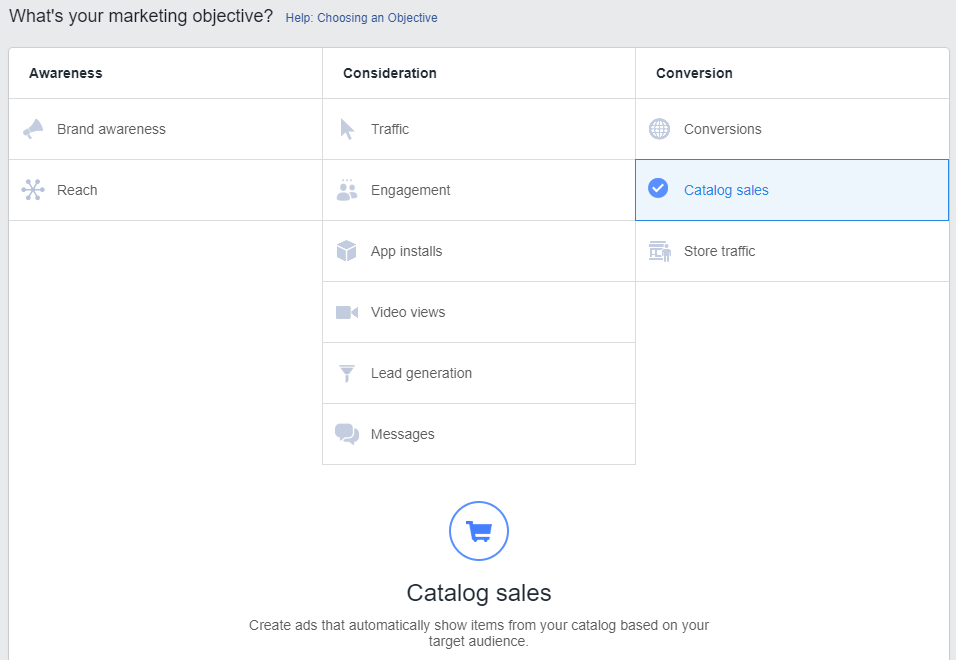
When should you use a Catalog sales objective?
I love the catalog sales objective.
In many ways, it is similar to Google shopping.
This is super relevant for eCommerce stores with an adequate size inventory and many SKUs.
In order to launch a Facebook campaign with the catalog sales objective, you are required to connect your product catalog. Once you do that, you can select the catalog from the drop down.

Additionally, the really cool audience targeting is the ability to automatically serve your catalog ads to audiences who:
- viewed and added to cart who didn’t purchase
- added to the cart and didn’t complete the checkout
- upsell and cross-sell products
- and customize your audience
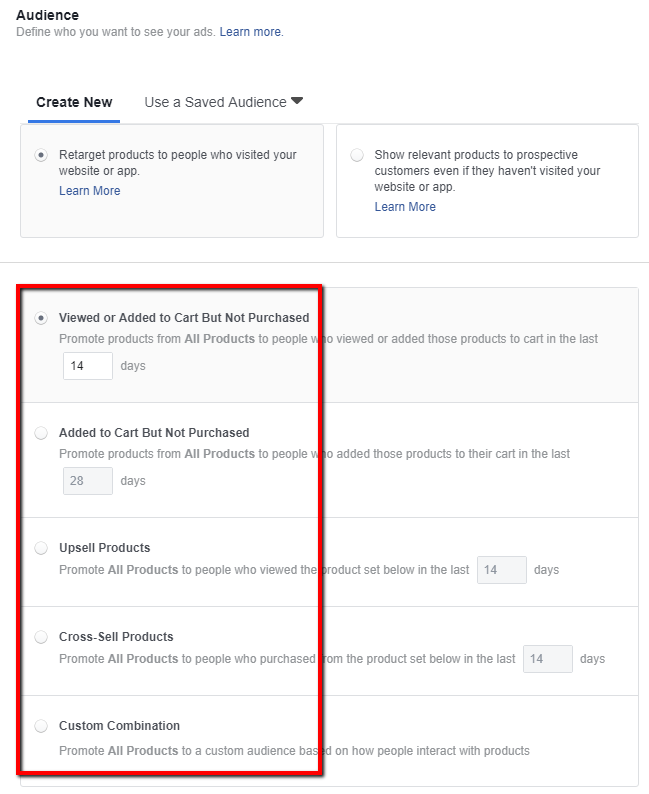
Depending on your customer shopping cycle, you can adjust your timing and optimize for the best results.
11) Campaign Objective: Store traffic

When should you use a Store traffic objective?
Get more people to visit your physical store.
Combine this objective with local targeting to drive more in-store traffic from your Facebook page.
Additionally, if you’re a retail brand with multiple locations, the store traffic objective can amplify any in-store promotions.
We talk a lot about how offline and online can complement each other — this is the perfect strategy.
Customer-based approach to setting objectives
Adopt the mindset of adding customer value and a customer-based campaign strategy. It’s the only thing that matters.
When you start building your next Facebook campaign, write down your business objective and brand goals.
Use that to help you decide what Facebook campaign objective is the best fit for you.

